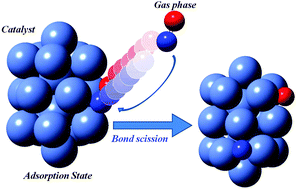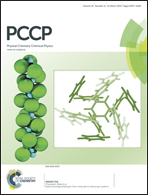Catalytic enhancement in dissociation of nitric oxide over rhodium and nickel small-size clusters: a DFT study†
Abstract
We applied density-functional theory (DFT) to investigate the adsorption and dissociation of NO on Rh19 and Ni19 clusters with a double-icosahedral (DI) structure. The transition structures of the NO dissociating on the potential-energy surfaces were derived using the nudged-elastic-band (NEB) method. The adsorption energies of NO molecules on the rhombus-center region of DI clusters are −2.53 eV and −2.78 eV with the N–O bond elongated to 1.33 Å and 1.35 Å, respectively, on Ni19 and Rh19, compared to 1.16 Å of the gaseous NO counterpart. The barriers to dissociation of N–O on both DI-Rh19 (Ea = 0.24 eV) and DI-Ni19 (Ea = 0.42 eV) clusters are small, indicating that the rhombus-center region of DI metal clusters might activate the scission of the N–O bond. To understand the interaction between these nanocluster catalysts and their adsorbates, we calculated the electronic properties including the local densities of states, orbital evolution of the adsorbates and interaction energies; the results indicate that a profound catalytic behavior for bond scission is observed in this unique rhombus-center region of DI metal-nanoclusters.


 Please wait while we load your content...
Please wait while we load your content...